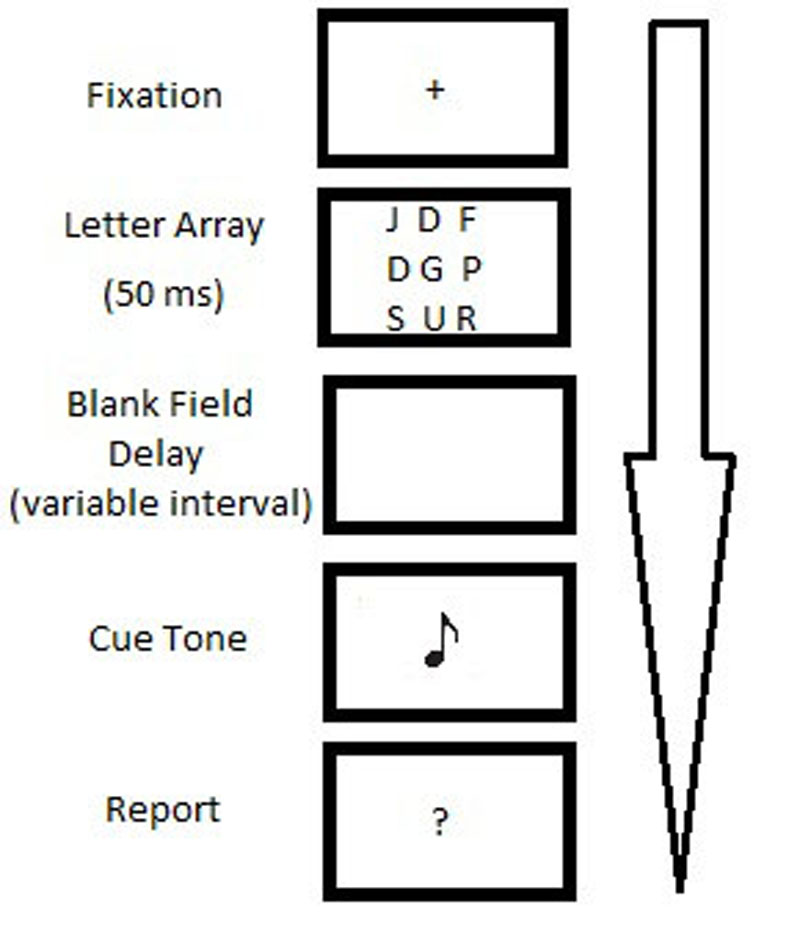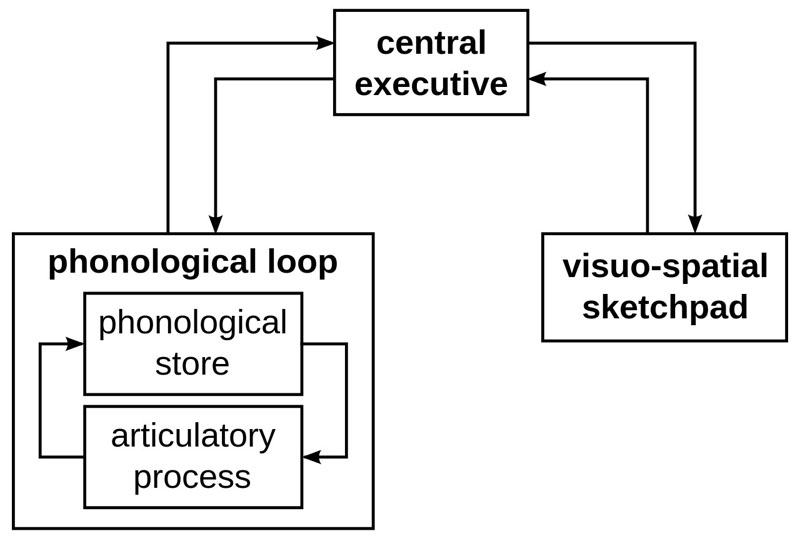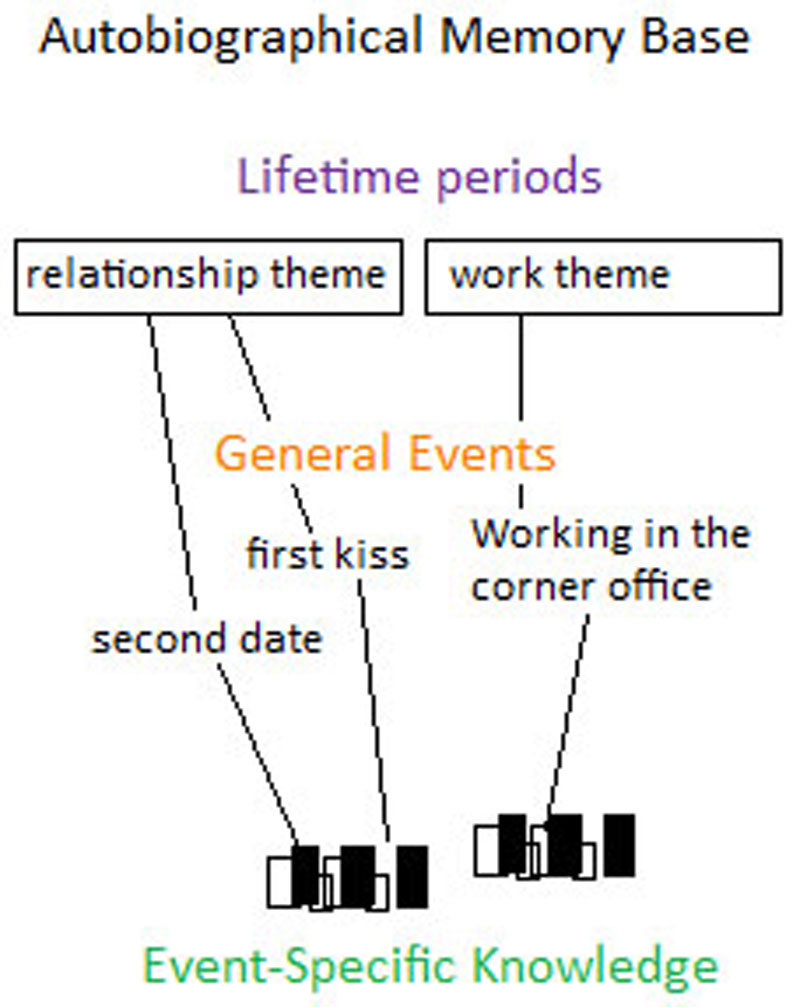Types of Memory
- Sensory information taken in by sensory receptors and processed by the nervous system is briefly stored in sensory memory before it is passed to short-term memory.
- Iconic memory is the visual sensory memory register pertaining to the visual domain and a fast-decaying store of visual information.
- Eidetic memory is an ability to recall images, sounds, or objects in memory after only a few instances of exposure, with high precision for some time after exposure, without using mnemonics. It occurs in a small number of children and generally is not found in adults.
- George Sperling demonstrated iconic memory using the method of partial report which involved delivering a request of which area of a visual impression to access and report in the form a cue arriving 250 milliseconds after the image flash disappeared.
- Echoic memory is one of the sensory memory registers; a component of sensory memory that is specific to retaining auditory information.
- Short-term memory is the capacity for holding a small amount of information in mind in an active, readily available state for a short period of time believed to be in the order of seconds.
- Working memory is responsible for the transient holding and processing of new and already-stored information, and is an important process for reasoning, comprehension, learning and memory updating. It is often used synonymously with short-term memory, but the two concepts are different.
- 'The Magical Number Seven, Plus or Minus Two: Some Limits on Our Capacity for Processing Information' one of the most highly cited papers in psychology, is often interpreted to argue that the number of objects an average human can hold in working memory is 7 ± 2, frequently referred to as Miller's Law.
- Free recall is a basic paradigm in the psychological study of memory in which participants study a list of items on each trial, and then are prompted to recall the items in any order. Items are usually presented one at a time for a short duration.
- The primacy effect is a cognitive bias that results in a subject recalling primary information presented better than information presented later on. For example, a subject who reads a sufficiently long list of words is more likely to remember words toward the beginning than words in the middle.
- The recency effect is a cognitive bias that results in a subject recalling information presented more recently better than information presented earlier.
- Serial position effect is the tendency of a person to recall the first and last items in a series best, and the middle items worst.
- The Von Restorff effect predicts that an item that 'stands out like a sore thumb' (called distinctive encoding) is more likely to be remembered than other items. It is a bias in favor of remembering the unusual.
- Chunking is a phenomenon whereby individuals group responses when performing a memory task, forming clusters of responses based on the items' semantic relatedness or perceptual features.
- Rehearsal is a term for the role of repetition in the retention of memories. It involves repeating information over and over in order to get the information processed and stored as a memory.
- Maintenance rehearsal involves repeating information without thinking about its meaning or connecting it to other information. While useful in maintaining information in short term memory or working memory, it is not an effective way of transfering the information into long term memory.
- The levels-of-processing effect describes memory recall of stimuli as a function of the depth of mental processing. Deeper levels of analysis produce more elaborate, longer lasting, and stronger memory traces than shallow levels of analysis.
- Long-term memory is the final stage of the dual memory model proposed by Atkinson and Shiffrin, in which data can be stored for long periods of time.
- Permastore is a type of long-term memory that appears to be permanent.
- Explicit memory is the conscious, intentional recollection of previous experiences and information.
- Episodic memory is the memory of autobiographical events that can be explicitly stated. It is the type of explicit memory involving the collection of past personal experiences that occurred at a particular time and place.
- Semantic memory is the type of explicit memory that refers to general world knowledge that we have accumulated throughout our lives. This general knowledge (facts, ideas, meaning and concepts) is intertwined in experience and dependent on culture.
- Autobiographical memory is a memory system consisting of episodes recollected from an individual's life, based on a combination of episodic and semantic memory.
- Implicit memory is a type of memory in which previous experiences aid the performance of a task without conscious awareness of these previous experiences.
- Priming is an implicit memory effect in which exposure to one stimulus influences the response to another stimulus.
- The word stem completion task is a verbal test of perceptual implicit memory. In this task a participant is presented with the first few letters of a word and asked to complete the word with the first word that they can think of.
- Procedural memory is a type of implicit memory. It is the memory for the performance of particular types of action.

The partial report condition required participants to identify a subset of the characters from the visual display using cued recall. This type of sampling revealed that immediately after stimulus offset most letters of the entire visual display was accessible to memory through the iconic memory system.

In working memory model, working memory consists of three basic stores: the central executive, the phonological loop and the visuo-spatial sketchpad.

The autobiographical knowledge base contains knowledge of the self, used to provide information on what the self is, what the self was, and what the self can be. This information is categorized into three broad areas: lifetime periods, general events, and event-specific knowledge.
![For instance, Kanizsa in 1979 showed a picture that could be interpreted as either a white vase on a black background or 2 faces facing each other on a white background.[34] The participants were primed to see the vase. Later they were shown the picture again but this time they were primed to see the black faces on the white background. Although this was the same picture as they had seen before, when asked if they had seen this picture before, they said no. The reason for this was that they had been primed to see the vase the first time the picture was presented, and it was therefore unrecognizable the second time as two faces. This demonstrates that the stimulus is understood within the context it is learned in as well the general rule that what really constitutes good learning are tests that test what has been learned in the same way that it was learned.[34] Therefore, to truly be efficient at remembering information, one must consider the demands that future recall will place on this information and study in a way that will match those demands.](/image_psych_archive/0505000100000000080.jpg)
![For instance, Kanizsa in 1979 showed a picture that could be interpreted as either a white vase on a black background or 2 faces facing each other on a white background.[34] The participants were primed to see the vase. Later they were shown the picture again but this time they were primed to see the black faces on the white background. Although this was the same picture as they had seen before, when asked if they had seen this picture before, they said no. The reason for this was that they had been primed to see the vase the first time the picture was presented, and it was therefore unrecognizable the second time as two faces. This demonstrates that the stimulus is understood within the context it is learned in as well the general rule that what really constitutes good learning are tests that test what has been learned in the same way that it was learned.[34] Therefore, to truly be efficient at remembering information, one must consider the demands that future recall will place on this information and study in a way that will match those demands.](/image_psych_archive/0505000100000000040.jpg)